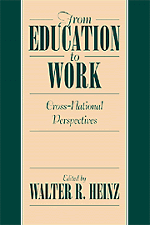Book contents
- Frontmatter
- Contents
- Contributing Authors
- Preface
- Introduction: Transitions to Employment in a Cross-National Perspective
- Part I Social Origin, Gender, and Transition Patterns
- Part II Education and Labour Markets: Work Experiences, Skills, and Credentials
- 5 Adolescent Part-Time Work and Postsecondary Transition Pathways in the United States
- 6 Multiple Life-Sphere Participation by Young Adults
- 7 The Subbaccalaureate Labor Market in the United States: Challenges for the School-to-Work Transition
- 8 Creating New Pathways to Adulthood by Adapting German Apprenticeship in the United States
- 9 Job-Entry Patterns in a Life-Course Perspective
- Part III Changes in the Social Context of Transitions
- References
- Index
7 - The Subbaccalaureate Labor Market in the United States: Challenges for the School-to-Work Transition
Published online by Cambridge University Press: 30 September 2009
- Frontmatter
- Contents
- Contributing Authors
- Preface
- Introduction: Transitions to Employment in a Cross-National Perspective
- Part I Social Origin, Gender, and Transition Patterns
- Part II Education and Labour Markets: Work Experiences, Skills, and Credentials
- 5 Adolescent Part-Time Work and Postsecondary Transition Pathways in the United States
- 6 Multiple Life-Sphere Participation by Young Adults
- 7 The Subbaccalaureate Labor Market in the United States: Challenges for the School-to-Work Transition
- 8 Creating New Pathways to Adulthood by Adapting German Apprenticeship in the United States
- 9 Job-Entry Patterns in a Life-Course Perspective
- Part III Changes in the Social Context of Transitions
- References
- Index
Summary
I define the subbaccalaureate labor market (SBLM) as the market for individuals with less than a baccalaureate degree but at least a secondary-school diploma. It is useful to define this segment of the labor market because its members compete with one another for moderately skilled jobs: high school dropouts are not considered for most of these positions, whereas those with less than a baccalaureate degree are generally prevented from entering certain managerial and professional occupations. Defining a labor market in terms of education credentials also provides useful information for individuals making choices about schooling and employment, and for education institutions (and the policy makers influencing them) trying to improve the preparation of the workforce. Finally, the demand side of the SBLM proves to differ in several ways from that for professional and managerial occupations.
The SBLM is a large and rapidly growing part of the labor force in the United States. The group with “some college” represented 13.1% of the labor force in 1967 but 21% in 1988 and 28.3% in 1992. In addition, those with a high school diploma accounted for 34.1% by 1992, so the SBLM includes about three fifths of all workers. By contrast, the portion of the labor force with baccalaureate and graduate degrees increased from 11.6% to 22.5% in 1988, to 23.7% in 1992, leaving this group only one third the size of the subbaccalaureate group.
- Type
- Chapter
- Information
- From Education to WorkCross National Perspectives, pp. 171 - 193Publisher: Cambridge University PressPrint publication year: 1999
- 7
- Cited by



